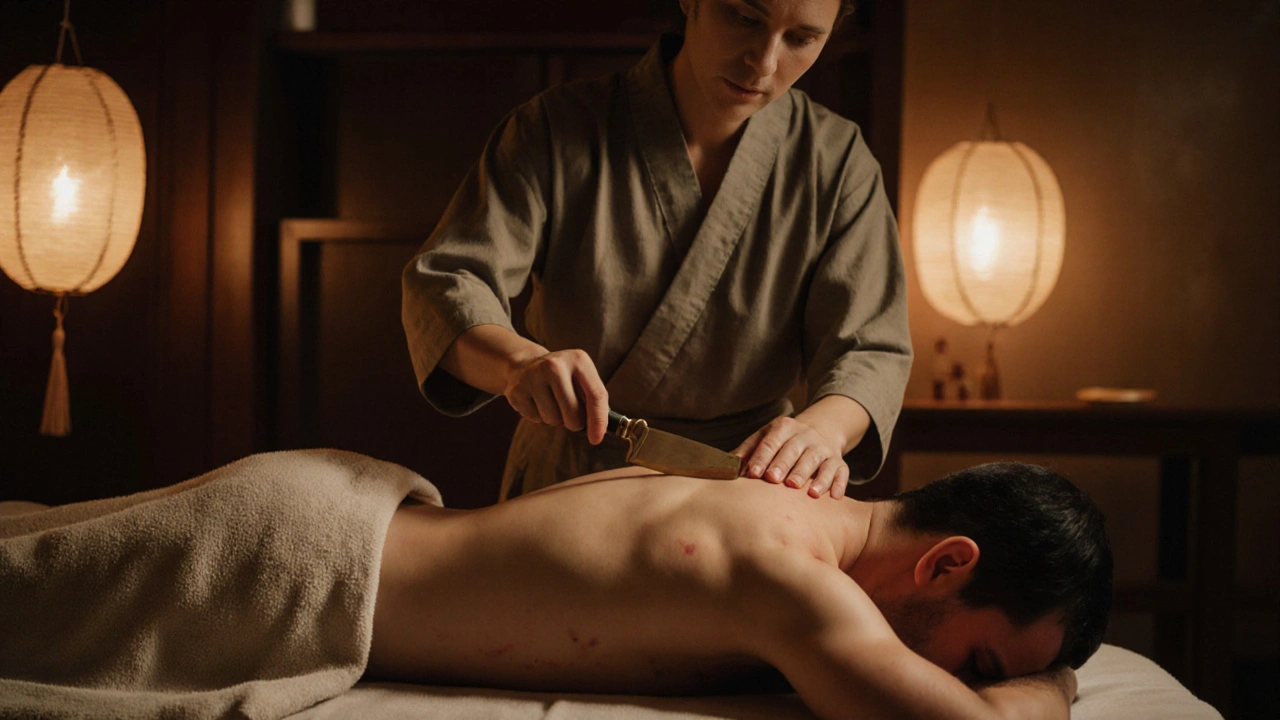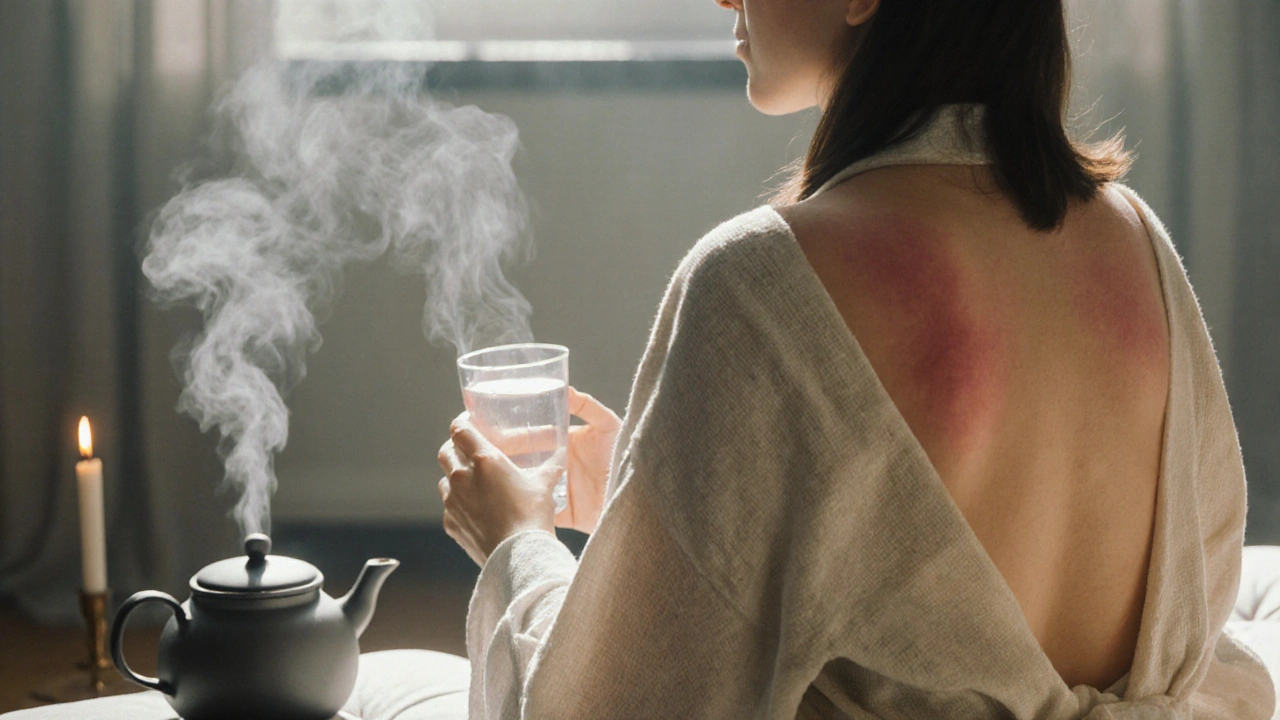How to Prepare for Your First Knife Massage
 Nov, 15 2025
Nov, 15 2025
Knife massage might sound like something out of a myth or a horror movie, but it’s a real practice - one that’s been used for centuries in parts of Asia, especially in China and Vietnam. It’s not about cutting skin. It’s about pressure, rhythm, and energy flow. Practitioners use blunt, polished blades - usually made of stainless steel or bronze - to glide over the body’s surface. The goal? To release tension, improve circulation, and stimulate acupressure points without breaking the skin. If you’re considering your first knife massage, you’re not just trying something new. You’re stepping into a tradition that’s as much about trust as it is about technique.
Understand What Knife Massage Actually Is
Let’s clear up the biggest myth right away: no one is slicing you open. The blades used in knife massage are rounded, smooth, and never sharp enough to cut. They’re typically 10-15 centimeters long, with a curved edge designed to fit the contours of the back, shoulders, or legs. The pressure is firm but controlled - like a deep tissue massage with a metal tool instead of thumbs. Some people describe it as a mix between a hot stone massage and a scalp massage, but with a metallic glide that feels oddly grounding.
Practitioners often work along meridians - energy pathways from traditional Chinese medicine. The blade doesn’t just move over the skin; it’s used to trace lines that correspond to organ systems. For example, strokes along the spine might target the bladder meridian, which is linked to kidney function and lower back health. The sensation isn’t painful, but it’s intense. You’ll feel vibrations, warmth, and sometimes a tingling that spreads through your muscles.
Find a Qualified Practitioner
This isn’t a service you book on a random app. Knife massage requires training, experience, and cultural understanding. In Melbourne, there are only a handful of certified practitioners. Look for someone who’s trained under a lineage - not just someone who watched a YouTube video. Ask if they’ve studied with a master in China, Vietnam, or Taiwan. Check if they’ve completed a formal apprenticeship. Reputable practitioners will have photos of their training, certificates, or even testimonials from long-term clients.
Don’t be afraid to ask questions. How long have they been practicing? How many sessions have they done? Do they use stainless steel or bronze blades? (Bronze is traditional and warms slightly with body heat; stainless is easier to sterilize.) A good practitioner will explain their process clearly and won’t rush you. If they seem dismissive of your concerns, walk away.
Prepare Your Body and Mind
Knife massage isn’t like a regular massage where you show up in workout clothes. You need to be ready - physically and mentally. In the 24 hours before your session:
- Avoid alcohol and heavy caffeine. Both can make your nervous system overreact to the sensation.
- Don’t apply lotions, oils, or body scrubs. The blade needs to glide smoothly, and oils can make it slip unpredictably.
- Hydrate well. Your skin and muscles respond better when they’re hydrated.
- Wear loose, comfortable clothing. You’ll be asked to remove your top (or wear a thin cotton wrap), so choose something easy to take off.
Mentally, this is where most people struggle. The idea of metal on skin triggers fear - even if you know it’s safe. Try this: spend five minutes before bed the night before visualizing the blade gliding over your skin. Imagine the warmth, the pressure, the release. This isn’t magic - it’s neuroplasticity. Your brain learns to associate the sensation with calm, not danger.

What to Expect During the Session
Most sessions last between 45 and 75 minutes. You’ll lie face down on a padded table, usually draped with a thin towel. The practitioner will start with light strokes on your back, testing your sensitivity. They might begin at the base of your neck and move down to your lower back, then switch to your shoulders or thighs.
You’ll feel the blade more than you feel pressure. It’s not about digging in - it’s about sliding. The practitioner uses the weight of the blade and the movement of their wrist, not brute force. If you feel any sharpness, pain, or burning, speak up immediately. A good practitioner will adjust on the spot. They might switch to a different blade, slow down, or use a gentler stroke.
Some people feel a wave of heat during the session. Others feel tingling in their fingers or toes - signs of improved circulation. It’s common to feel slightly dizzy or lightheaded afterward. That’s normal. Your nervous system has been reset. Don’t stand up too fast. Drink water. Rest for 10-15 minutes after.
Post-Session Care
Your skin might look slightly red - like a mild sunburn - but it shouldn’t bruise. If it does, that’s a red flag. The blade shouldn’t cause trauma. Any redness should fade within a few hours.
- Drink at least two glasses of water within an hour after the session.
- Avoid hot showers or saunas for 6-8 hours. Your pores are open, and extreme heat can overstimulate your system.
- Don’t do intense exercise or heavy lifting for 24 hours. Your muscles are in recovery mode.
- Keep your skin moisturized with a light, unscented oil or lotion. Coconut or jojoba oil works well.
Some people report feeling deeply relaxed. Others feel energized. A few feel emotionally released - tears, laughter, or sudden calm. These aren’t side effects. They’re signs the massage worked on your nervous system, not just your muscles.

Who Should Avoid Knife Massage
It’s not for everyone. Avoid knife massage if you:
- Have open wounds, rashes, or active skin infections
- Are on blood thinners or have a bleeding disorder
- Are pregnant (especially in the first and third trimesters)
- Have severe osteoporosis or fragile bones
- Have a pacemaker or implanted medical device (the metal blade can interfere with electromagnetic fields)
- Have uncontrolled high blood pressure
If you’re unsure, talk to your doctor. Bring the practitioner’s information with you. Many doctors are unfamiliar with knife massage, but they’ll respect a well-informed patient.
How Many Sessions Do You Need?
One session can be enough to feel a difference - especially if you’re carrying chronic tension in your upper back or neck. But for lasting results, most practitioners recommend a series. A common starting plan is:
- First session: Introduction and assessment
- Second session: 7-10 days later - deeper work
- Third session: 2-3 weeks later - maintenance and refinement
After that, monthly sessions are typical for people who use it for stress relief or chronic pain. Athletes sometimes use it weekly during training cycles. It’s not a cure-all, but for those who respond to it, it’s one of the most effective tools for releasing deep muscular knots.
Why It Works - The Science Behind the Blade
There’s growing research on how mechanical pressure affects fascia - the connective tissue that wraps around muscles. A 2023 study from the University of Sydney’s School of Physiotherapy found that sustained, rhythmic pressure on fascial planes (like those created by knife massage) increased tissue hydration and reduced stiffness by up to 38% in participants with chronic upper back pain. The blade’s edge creates a unique vibration pattern that’s different from fingers or foam rollers. That vibration seems to disrupt pain signals in the nervous system.
It’s also linked to parasympathetic activation - the body’s “rest and digest” mode. The rhythmic, predictable motion of the blade calms the fight-or-flight response. That’s why people often feel calm, even euphoric, after a session.
It’s not a placebo. The results are measurable. But they require the right practitioner, the right preparation, and the right mindset.
Is knife massage dangerous?
No, when done by a trained professional. The blades are blunt and polished, and practitioners are trained to apply pressure without breaking the skin. Injuries are extremely rare - less than 0.2% of reported cases, according to a 2024 review in the Journal of Traditional Bodywork Therapies. Always choose a certified practitioner.
Does it hurt?
It shouldn’t hurt. You’ll feel pressure, heat, and vibration - sometimes intense, but not sharp or stabbing. If it hurts, tell the practitioner immediately. Pain means something’s wrong. A good session feels like deep release, not pain.
Can I do knife massage at home?
Strongly discouraged. Even if you buy a blade online, you don’t have the training to know where to apply pressure, how much to use, or how to avoid nerve clusters. Home use has led to bruising, nerve irritation, and infections. This is a professional therapy - not a DIY tool.
How much does a knife massage cost in Melbourne?
Prices range from $90 to $150 for a 60-minute session, depending on the practitioner’s experience and location. Higher prices usually mean more training, longer sessions, and better aftercare. Avoid deals under $70 - they’re often unlicensed or unsafe.
How long do the effects last?
Most people feel relaxed for 24-48 hours. The physical benefits - reduced muscle stiffness, better circulation - can last up to a week. For chronic issues, regular sessions (every 2-4 weeks) help maintain results. It’s not a one-time fix, but a tool for ongoing wellness.
